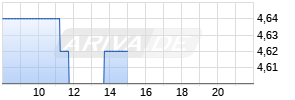
BH Macro Limited - Monthly Shareholder Report - April 2018
PR Newswire
London, May 31
| BH MACRO LIMITED MONTHLY SHAREHOLDER REPORT: APRIL 2018 YOUR ATTENTION IS DRAWN TO THE DISCLAIMER AT THE END OF THIS DOCUMENT | ||
| BH Macro Limited | Overview | |||||||||||||||||||||||||||||||||||||||||||||||||||||||||||||||||||||||||||||||||||||||||||||||||||||||||||||||||||||||||||||||||||||||||||||||||||||||||||||||||||||||||||||||||||||||
| Manager: Brevan Howard Capital Management LP (“BHCM”) Administrator: Northern Trust International Fund Administration Services (Guernsey) Limited (“Northern Trust”) Corporate Broker: J.P. Morgan Cazenove Listing: London Stock Exchange (Premium Listing) | BH Macro Limited (“BHM”) is a closed-ended investment company, registered and incorporated in Guernsey on 17 January 2007 (Registration Number: 46235). BHM invests all of its assets (net of short-term working capital) in the ordinary shares of Brevan Howard Master Fund Limited (the “Fund”). BHM was admitted to the Official List of the UK Listing Authority and to trading on the Main Market of the London Stock Exchange on 14 March 2007. | |||||||||||||||||||||||||||||||||||||||||||||||||||||||||||||||||||||||||||||||||||||||||||||||||||||||||||||||||||||||||||||||||||||||||||||||||||||||||||||||||||||||||||||||||||||||
| Total Assets: | $481 mm¹ | |||||||||||||||||||||||||||||||||||||||||||||||||||||||||||||||||||||||||||||||||||||||||||||||||||||||||||||||||||||||||||||||||||||||||||||||||||||||||||||||||||||||||||||||||||||||
| 1. As at 30 April 2018. Source: BHM's administrator, Northern Trust. | ||||||||||||||||||||||||||||||||||||||||||||||||||||||||||||||||||||||||||||||||||||||||||||||||||||||||||||||||||||||||||||||||||||||||||||||||||||||||||||||||||||||||||||||||||||||||
| Summary Information | BH Macro Limited NAV per Share (Calculated as at 30 April 2018) | |||||||||||||||||||||||||||||||||||||||||||||||||||||||||||||||||||||||||||||||||||||||||||||||||||||||||||||||||||||||||||||||||||||||||||||||||||||||||||||||||||||||||||||||||||||||
| ||||||||||||||||||||||||||||||||||||||||||||||||||||||||||||||||||||||||||||||||||||||||||||||||||||||||||||||||||||||||||||||||||||||||||||||||||||||||||||||||||||||||||||||||||||||||
| BH Macro Limited NAV per Share % Monthly Change | ||||||||||||||||||||||||||||||||||||||||||||||||||||||||||||||||||||||||||||||||||||||||||||||||||||||||||||||||||||||||||||||||||||||||||||||||||||||||||||||||||||||||||||||||||||||||
| ||||||||||||||||||||||||||||||||||||||||||||||||||||||||||||||||||||||||||||||||||||||||||||||||||||||||||||||||||||||||||||||||||||||||||||||||||||||||||||||||||||||||||||||||||||||||
| ||||||||||||||||||||||||||||||||||||||||||||||||||||||||||||||||||||||||||||||||||||||||||||||||||||||||||||||||||||||||||||||||||||||||||||||||||||||||||||||||||||||||||||||||||||||||
| Source: Fund NAV data is provided by the administrator of the Fund, International Fund Services (Ireland) Limited (“IFS”). BHM NAV and NAV per Share data is provided by BHM’s administrator, Northern Trust. BHM NAV per Share % Monthly Change is calculated by BHCM. BHM NAV data is unaudited and net of all investment management and all other fees and expenses payable by BHM. In addition, the Fund is subject to an operational services fee. With effect from 1 April 2017, the management fee is 0.5% per annum. BHM’s investment in the Fund is subject to an operational services fee of 0.5% per annum. No management fee or operational services fee is charged in respect of performance related growth of NAV for each class of share in excess of its level on 1 April 2017 as if the tender offer commenced by BHM on 27 January 2017 had completed on 1 April 2017. NAV performance is provided for information purposes only. Shares in BHM do not necessarily trade at a price equal to the prevailing NAV per Share. Data as at 30 April 2018 PAST PERFORMANCE IS NOT INDICATIVE OF FUTURE RESULTS. | ||||||||||||||||||||||||||||||||||||||||||||||||||||||||||||||||||||||||||||||||||||||||||||||||||||||||||||||||||||||||||||||||||||||||||||||||||||||||||||||||||||||||||||||||||||||||
| ASC 820 Asset Valuation Categorisation on a non look-through basis* ASC 820 Asset Valuation Categorisation on a look-through basis* Performance Review | Brevan Howard Master Fund Limited | |||||||||||||||||||||||||||||||||||||||||||||||||||||||||||||||||||||||||||||||||||||
| Unaudited as at 30 April 2018 | ||||||||||||||||||||||||||||||||||||||||||||||||||||||||||||||||||||||||||||||||||||||
Source: BHCM * This data is unaudited and has been calculated by BHCM using the same methodology as that used in the most recent audited financial statements of the Fund. The relative size of each category is subject to change. Sum may not total 100% due to rounding. Level 1: This represents the level of assets in the portfolio which are priced using unadjusted quoted prices in active markets that are accessible at the measurement date for identical, unrestricted assets or liabilities. Level 2: This represents the level of assets in the portfolio which are priced using either (i) quoted prices that are identical or similar in markets that are not active or (ii) model-derived valuations for which all significant inputs are observable, either directly or indirectly in active markets. Level 3: This represents the level of assets in the portfolio which are priced or valued using inputs that are both significant to the fair value measurement and are not observable directly or indirectly in an active market. At NAV: This represents the level of assets in the portfolio that are invested in other Brevan Howard funds and priced or valued at NAV.
Source: BHCM * This data reflects the combined ASC 820 levels of the Fund and the underlying allocations in which the Fund is invested, proportional to each of the underlying allocation’s weighting in the Fund’s portfolio. The data is unaudited and has been calculated by BHCM using the same methodology as that used in the most recent audited financial statements of the Fund and any underlying funds (as the case may be). The relative size of each category is subject to change. Sum may not total 100% due to rounding. Level 1: This represents the level of assets in the portfolio which are priced using unadjusted quoted prices in active markets that are accessible at the measurement date for identical, unrestricted assets or liabilities. Level 2: This represents the level of assets in the portfolio which are priced using either (i) quoted prices that are identical or similar in markets that are not active or (ii) model-derived valuations for which all significant inputs are observable, either directly or indirectly in active markets. Level 3: This represents the level of assets in the portfolio which are priced or valued using inputs that are both significant to the fair value measurement and are not observable directly or indirectly in an active market. The information in this section has been provided to BHM by BHCM. In April 2018, gains were primarily driven by short positioning in US interest rates, as well as from long positioning in short-dated UK interest rates. Further gains came from US interest rate basis trading and equity index trading. Small losses occurred in FX trading of the Japanese yen as well as from directional trading of European interest rates. The performance review and attributions are derived from data calculated by BHCM, based on total performance data for each period provided by the Fund’s administrator (IFS) and risk data provided by BHCM, as at 30 April 2018. | ||||||||||||||||||||||||||||||||||||||||||||||||||||||||||||||||||||||||||||||||||||||
| Manager's Market Review and Outlook Enquiries | Performance by Asset Class Monthly, quarterly and annual contribution (%) to the performance of BHM USD Shares (net of fees and expenses) by asset class as at 30 April 2018
PAST PERFORMANCE IS NOT INDICATIVE OF FUTURE RESULTS. Methodology and Definition of Contribution to Performance: Attribution by asset class is produced at the instrument level, with adjustments made based on risk estimates. The above asset classes are categorised as follows: “Rates”: interest rates markets “Equity”: equity markets including indices and other derivatives Performance by Strategy Group Monthly, quarterly and annual contribution (%) to the performance of BHM USD Shares (net of fees and expenses) by strategy group as at 30 April 2018
PAST PERFORMANCE IS NOT INDICATIVE OF FUTURE RESULTS. Methodology and Definition of Contribution to Performance: Strategy Group attribution is approximate and has been derived by allocating each trader book in the Fund to a single category. In cases where a trader book has activity in more than one category, the most relevant category has been selected. The above strategies are categorised as follows: “Macro”: multi-asset global markets, mainly directional (for the Fund, the majority of risk in this category is in rates) “Systematic”: rules-based futures trading “Rates”: developed interest rates markets “FX”: global FX forwards and options “Equity”: global equity markets including indices and other derivatives “Credit”: corporate and asset-backed indices, bonds and CDS “EMG”: global emerging markets “Commodity”: liquid commodity futures and options The information in this section has been provided to BHM by BHCM US The unemployment rate dropped to 3.9% in April, nearly matching some of the lows seen in the last 50 years. Payroll gains were well-maintained, with the average monthly increase over the last three months approximately 200,000. However, wages gains were mixed. The Employment Cost Index perked up in the first quarter, but average hourly earnings were subdued in April. The debate about how much slack remains in the labour market will continue. Q1 gross domestic product (“GDP”) rose by a better-than-expected 2.3% (annual rate), a soft patch that is nevertheless above the trend rate of growth of the economy. Some of the strength reflected the contributions of inventories and trade that may not be sustainable over the coming quarter. At the same time, consumption is unlikely to be as weak as seen in Q1 given the strong fundamentals in the household sector. Inflation reached the Federal Reserve’s (“Fed”) target in April, with headline personal consumption inflation hitting 2%, and core inflation rising to 1.9%. Notably, core inflation has been running at an annual rate of 2.3% over the last 6 months and is on track to hit 2% sometime in the summer. In Washington, the Fed changed little in its May statement, leaving it on track to raise rates again when it meets in June. Elsewhere in Washington, the Trump administration tried to diffuse trade tensions with Canada and Mexico, and started negotiations with China. It is hard to guess how the negotiations will eventually pan out. UK Consistent with the moderation in global growth, activity in the UK has moderated according to recent data. The latest estimates from the Office for National Statistics (“ONS”) showed that GDP grew 0.1% q/q in Q1, markedly slower compared to the 0.4% pace seen in Q4. Some of the weakness appeared to be temporary; for example construction was particularly weak, detracting 0.2ppts from GDP, and was likely reflective of the higher than usual snowfall. However, growth in both the service and manufacturing sectors were also more modest compared to recent history. The weakness apparent in March appears to have persisted; business surveys had failed to rebound materially in April, with the composite Purchasing Managers’ Index (“PMI”) only rising 0.8pts to 53.2, after having fallen 2.1pts in the month prior. GfK’s Consumer Confidence Index also fell in April by 2pts to -9, returning to long term average levels. Retail sales volumes have also been somewhat muted of late, barely growing over the past half year. The housing market has remained relatively soft, as has been the case since the referendum. House prices continue to grow around 2% y/y, down from the pace 6-7% seen in 2015 and the first half of 2016. Overall, data suggests that the pace of growth has moderated compared to the relatively resilient pace seen in 2017, but the economy is still expected to grow in line with potential growth over the next year. Despite less buoyant activity data, the labour market has continued to perform well, with employment growing 1.2% y/y as of March 18, and the unemployment rate is at a multi-decade low of 4.2%. The improvement in the labour market has also been finally matched with improved wage growth data. Average weekly earnings (excluding bonuses) are now running at a pace of 2.9% 3m/12m, the fastest pace since 2015. Surveys related to pay growth, like wage settlements or recruitment difficulties, also suggest that underlying wages may continue to improve. Meanwhile, headline inflation fell 0.2ppts in March to 2.5% y/y, whilst core inflation fell 0.1ppts to 2.3% y/y. Core inflation is expected to trend lower as the influence of the post-referendum depreciation in the exchange rate starts to fade. However, the most recent rise in oil prices should provide some support for headline inflation, likely keeping it above the 2% target throughout the next year. At the Bank of England’s (“BoE”) most recent Monetary Policy Committee (“MPC”) meeting in May, two members voted to raise the official bank rate a further 0.25% whilst the 7 person majority voted to keep rates unchanged at 0.5% (as was the case in the previous meeting). It appears as though the moderation in recent data had dissuaded the majority of MPC members from voting for a rate rise in May. However, the monetary policy statement still concluded that if the economy were to develop broadly in line with the May Inflation Report projections, ‘an ongoing tightening of monetary policy over the forecast period would be appropriate to return inflation sustainably to its target at a conventional horizon’. Meanwhile, the Brexit process continues to cloud the outlook for the United Kingdom. In March, the UK was able to secure a transition deal, conditional on a final withdrawal treaty, allowing the UK to stay in the single market and customs union until December 2020. The agreement also ensured that Northern Ireland will effectively stay in parts of the single market and customs union in the absence of other solutions. The next milestone will be the European Council meeting on June 28th where issues such as the Irish border, and terms for the future trade, are to be discussed. EMU In Q1 2018 the EMU economy grew by 0.4% q/q (1.6% annualised), marking a clear slowdown from the 0.7% q/q (2.8% annualised) pace of the previous four quarters, and way undershooting the 0.7% q/q prediction made by the European Central Bank (“ECB”) in the macroeconomic projection presented as recently as March. Although the moderation was exacerbated slightly by temporary effects, mostly related to unseasonably cold and snowy conditions in some regions, it appears mainly related to a downshift in underlying growth dynamics. Indeed, the slowdown in hard data was matched by the drop recorded in most relevant business conditions surveys, from the EMU PMI, to the German ifo Business Climate Index (“IFO”). Most importantly, business confidence continued to slip into Q2, as EMU PMI orders, the most relevant cyclical component, fell from 55.0 to 54.5, the lowest level since January 2017, while the Expectations component of the IFO dropped from 100 to 98.7, the lowest in two years. Behind this slowdown, which was quite widespread with the exception of Spain, is the lagged effect of the appreciation of the euro in 2017, the diminishing impulse provided by the ECB quantitative easing through the credit channel, and slower imports from China of European goods. These factors had contributed to the significant acceleration of activity in 2017, in an opposite direction. The drop of core inflation to 0.7% y/y in April, although exaggerated by an Easter effect, supported the notion that underlying price dynamics are not improving in a way consistent with the self-sustaining path toward the medium term ECB objective, which the President of the ECB, Mario Draghi stated as being the main condition to end net security purchases by the ECB from September onward. Japan The Bank of Japan (“BoJ”) announced no changes to its current policy after its late April policy meeting. Analysts saw meaning in a change to the quarterly outlook report. In January, the BoJ wrote: “the timing of the year-on-year rate of change in the consumer price index (“CPI”) reaching around 2 percent will likely be around fiscal 2019”. The April report merely noted that “comparing the current projections through fiscal 2019 with the previous ones, the projected rates of increase in the CPI are more or less unchanged”. The structure of official communications tends not to be written from new every time, so it is natural to surmise some meaning in the change. At the same time, the forecast for the core CPI in fiscal year 2019 was the same in April as it was in January. One does run the risk of taking these forecasts too seriously. The forecast for 2018 was marked down by 0.1pp to 1.3%. Even so, to reach that rate, over the next 12 months the core rate will have to move up to average a 1.6% annual rate, double the rate seen through March of this year. That still seems optimistic given that the latest western core index unwound the cumulative increases over the first two months of the year. However, some fundamentals are a little more constructive. Over the last month or so, the yen has depreciated about 2% against the dollar, and consumer inflation expectations rose 0.1pp in April. Activity has downshifted somewhat, which was evident in some of the survey data, though not uniformly. In Q1 2018, real GDP declined 0.6%, at an annual rate, following a moderate 0.6% gain in Q4. That stands in contrast to the 2.2% average rate seen over the first three quarters of 2017. The Economy Watchers index was essentially at a middling level. IHS Markit Purchasing Managers’ surveys have essentially moved sideways for over a year, but in contrast to the Economy Watchers index, at a more constructive level. The Company Secretary Northern Trust International Fund Administration Services (Guernsey) Limited bhfa@ntrs.com +44 (0) 1481 745736 |
Important Legal Information and Disclaimer
BH Macro Limited (“BHM") is a feeder fund investing in Brevan Howard Master Fund Limited (the "Fund"). Brevan Howard Capital Management LP (“BHCM”) has supplied certain information herein regarding BHM’s and the Fund’s performance and outlook.
The material relating to BHM and the Fund included in this report is provided for information purposes only, does not constitute an invitation or offer to subscribe for or purchase shares in BHM or the Fund and is not intended to constitute “marketing” of either BHM or the Fund as such term is understood for the purposes of the Alternative Investment Fund Managers Directive as it has been implemented in states of the European Economic Area. This material is not intended to provide a sufficient basis on which to make an investment decision. Information and opinions presented in this material relating to BHM and the Fund have been obtained or derived from sources believed to be reliable, but none of BHM, the Fund or BHCM make any representation as to their accuracy or completeness. Any estimates may be subject to error and significant fluctuation, especially during periods of high market volatility or disruption. Any estimates should be taken as indicative values only and no reliance should be placed on them. Estimated results, performance or achievements may materially differ from any actual results, performance or achievements. Except as required by applicable law, BHM, the Fund and BHCM expressly disclaim any obligations to update or revise such estimates to reflect any change in expectations, new information, subsequent events or otherwise.
Tax treatment depends on the individual circumstances of each investor in BHM and may be subject to change in the future. Returns may increase or decrease as a result of currency fluctuations.
You should note that, if you invest in BHM, your capital will be at risk and you may therefore lose some or all of any amount that you choose to invest. This material is not intended to constitute, and should not be construed as, investment advice. All investments are subject to risk. You are advised to seek expert legal, financial, tax and other professional advice before making any investment decisions.
THE VALUE OF INVESTMENTS CAN GO DOWN AS WELL AS UP. YOU MAY NOT GET BACK THE AMOUNT ORIGINALLY INVESTED AND YOU MAY LOSE ALL OF YOUR INVESTMENT. PAST PERFORMANCE IS NOT A RELIABLE INDICATOR OF FUTURE RESULTS.
Risk Factors
Acquiring shares in BHM may expose an investor to a significant risk of losing all of the amount invested. Any person who is in any doubt about investing in BHM (and therefore gaining exposure to the Fund) should consult an authorised person specialising in advising on such investments. Any person acquiring shares in BHM must be able to bear the risks involved. These include the following:
• The Fund is speculative and involves substantial risk.
• The Fund will be leveraged and will engage in speculative investment practices that may increase the risk of investment loss. The Fund may invest in illiquid securities.
• Past results of the Fund’s investment managers are not necessarily indicative of future performance of the Fund, and the Fund’s performance may be volatile.
• An investor could lose all or a substantial amount of his or her investment.
• The Fund’s investment managers have total investment and trading authority over the Fund, and the Fund is dependent upon the services of the investment managers.
• Investments in the Fund are subject to restrictions on withdrawal or redemption and should be considered illiquid. There is no secondary market for investors’ interests in the Fund and none is expected to develop.
• The investment managers’ incentive compensation, fees and expenses may offset the Fund’s trading and investment profits.
• The Fund is not required to provide periodic pricing or valuation information to investors with respect to individual investments.
• The Fund is not subject to the same regulatory requirements as mutual funds.
• A portion of the trades executed for the Fund may take place on foreign markets.
• The Fund and its investment managers are subject to conflicts of interest.
• The Fund is dependent on the services of certain key personnel, and, were certain or all of them to become unavailable, the Fund may prematurely terminate.
• The Fund’s managers will receive performance-based compensation. Such compensation may give such managers an incentive to make riskier investments than they otherwise would.
• The Fund may make investments in securities of issuers in emerging markets. Investment in emerging markets involve particular risks, such as less strict market regulation, increased likelihood of severe inflation, unstable currencies, war, expropriation of property, limitations on foreign investments, increased market volatility, less favourable or unstable tax provisions, illiquid markets and social and political upheaval.
The above summary risk factors do not purport to be a complete description of the relevant risks of an investment in shares of BHM or the Fund and therefore reference should be made to publicly available documents and information.

Mehr Nachrichten zur BH Macro Ltd Aktie kostenlos abonnieren
(Mit der Bestellung akzeptierst du die Datenschutzhinweise)

Hinweis: ARIVA.DE veröffentlicht in dieser Rubrik Analysen, Kolumnen und Nachrichten aus verschiedenen Quellen. Die ARIVA.DE AG ist nicht verantwortlich für Inhalte, die erkennbar von Dritten in den „News“-Bereich dieser Webseite eingestellt worden sind, und macht sich diese nicht zu Eigen. Diese Inhalte sind insbesondere durch eine entsprechende „von“-Kennzeichnung unterhalb der Artikelüberschrift und/oder durch den Link „Um den vollständigen Artikel zu lesen, klicken Sie bitte hier.“ erkennbar; verantwortlich für diese Inhalte ist allein der genannte Dritte.




